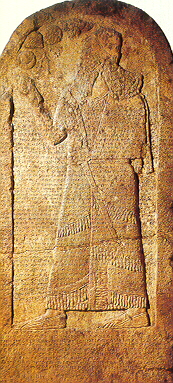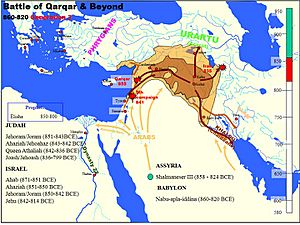Shalmaneser III facts for kids
Quick facts for kids Shalmaneser III |
|
|---|---|
|
|
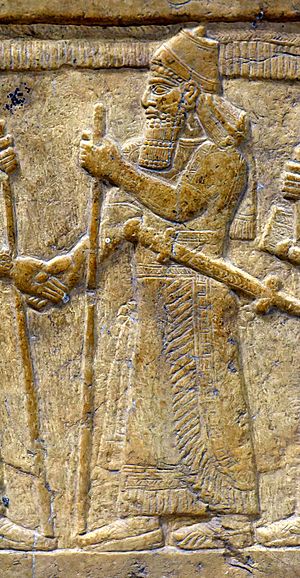
Shalmaneser III, on the Throne Dais of Shalmaneser III at the Iraq Museum.
|
|
| King of the Neo-Assyrian Empire | |
| Reign | 859–824 BC |
| Predecessor | Ashurnasirpal II |
| Successor | Shamshi-Adad V |
| Born | 893-891 BC |
| Died | c. 824 BC |
| Father | Ashurnasirpal II |
| Mother | Mullissu-mukannishat-Ninua (?) |
Shalmaneser III was a powerful king of the Neo-Assyrian Empire. He ruled for a long time, from 859 BC to 824 BC. His father was Ashurnasirpal II. Shalmaneser's name means "the god Shulmanu is pre-eminent."
During his many years as king, Shalmaneser III led his armies on many campaigns. He fought against different groups and kingdoms in the east, in Babylon, and across Mesopotamia and Syria. His armies even reached Lake Van and the Taurus Mountains. He made the Neo-Hittites pay him tribute, and he took control of the kingdoms of Hamath and Aram Damascus. It was during Shalmaneser III's time, around 850 BC, that the Arabs and Chaldeans are first mentioned in history.
Contents
Shalmaneser III: A King of Many Battles
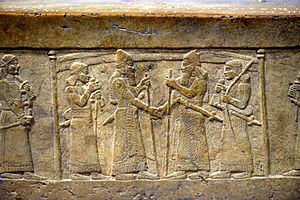
Early Campaigns and Big Battles
Shalmaneser began his rule by fighting against the Urartian Kingdom. In 858 BC, he destroyed the city of Sugunia. Later, in 853 BC, he also destroyed Araškun. These cities were likely important centers for the Urartians before Tushpa became their main city.
In 853 BC, many states joined together to fight Shalmaneser. This group included 11 kingdoms, led by Hadadezer, the king of Damascus, and Irhuleni, the king of Hamath. Even Ahab, the king of Israel, and Gindibu, the king of the Arabs, were part of this alliance. They fought against the Assyrian king at the Battle of Qarqar. The battle did not have a clear winner. Shalmaneser III had to fight these enemies many more times. Eventually, the Assyrian Empire took control of the area known today as Syria, Lebanon, and Arabia.
Helping a Friend in Babylon
In 851 BC, Shalmaneser helped his friend, King Marduk-zakir-shumi I of Babylon. Marduk-zakir-shumi's younger brother, Marduk-bēl-ušate, had started a rebellion. Shalmaneser led his army to help. In the second year of this fight, Marduk-bēl-ušate was forced to run away and was later killed.
This event is recorded on a famous stone monument called the Black Obelisk. It says that Shalmaneser marched out to help his friend. He chased Marduk-bēl-ušate into the mountains. Finally, he defeated Marduk-bēl-ušate and his rebel army.
Conquering Israel and Other Lands
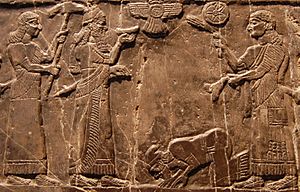
In 841 BC, Shalmaneser fought against Hazael, who had taken over from Hadadezer as king of Damascus. Shalmaneser forced Hazael to hide inside his capital city. Even though Shalmaneser could not capture Damascus, he destroyed much of its land.
Around this time, Jehu, the king of Israel, wisely sent gifts to Shalmaneser. The Phoenician cities also sent tribute. These events are shown on the Black Obelisk, which is now in the British Museum. Shalmaneser had also taken control of Babylonia, including areas where different tribes lived. The Babylonian king was killed.
Later Years and a Family Rebellion
In 836 BC, Shalmaneser sent his army to fight against the Tibareni people. After that, he sent them to Cappadocia. In 832 BC, he had another campaign against Urartu.
As Shalmaneser grew older, he gave command of his armies to his chief general, Dayyan-Assur. Six years later, his son Assur-danin-pal started a rebellion against him. Cities like Nineveh joined the revolt. A Civil war lasted for two years. But another son of Shalmaneser, Shamshi-Adad V, finally crushed the rebellion. Shalmaneser died soon after this.
Even with the rebellion at the end of his rule, Shalmaneser was very successful. He made the Neo-Assyrian Empire much larger. He also made sure Assyria had strong control over important areas like the Khabur region and the Zagros mountains, which were often fought over with Urartu.
Shalmaneser III in the Bible
Shalmaneser III's reign is important for people who study the Hebrew Bible. Two of his monuments mention rulers from the Bible. The Black Obelisk names Jehu, king of Israel. The Kurkh Monolith names King Ahab, who fought in the Battle of Qarqar.
Building Projects and the Black Obelisk
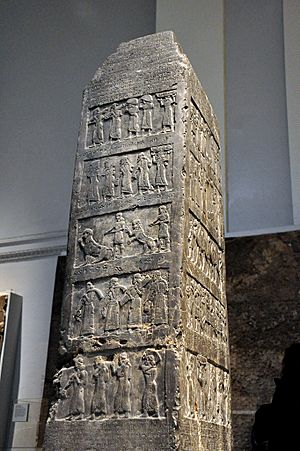
Shalmaneser III built a palace in a city called Kalhu (also known as Biblical Calah, or modern Nimrud). He also created several records of his military campaigns. The last of these records is carved onto the Black Obelisk, which was found in Kalhu.
The Black Obelisk is a very important artifact from Shalmaneser's time. It is a tall, black limestone sculpture with carvings. It was found in Nimrud (ancient Kalhu), in northern Iraq. It is the most complete Assyrian obelisk ever found. It is also historically important because it shows the earliest picture of an Israelite person.
At the top and bottom of the carvings, there is a long message written in cuneiform. This message records all the military campaigns that the king and his chief general led each year, up to the thirty-first year of his reign. Some people think that the general, Dayyan-Ashur, might have ordered this monument to be made.
The second row of carvings from the top shows the earliest picture of an Israelite. It is Jehu, the king of Israel. Jehu had stopped Israel's alliances with Phoenicia and Judah. He then became loyal to Assyria. The carvings show how Jehu brought or sent his tribute around 841 BC. The writing above the scene, in Assyrian cuneiform, says:
"The tribute of Jehu, son of Omri: I received from him silver, gold, a golden bowl, a golden vase with pointed bottom, golden tumblers, golden buckets, tin, a staff for a king [and] spears."
The Black Obelisk was put up as a public monument in 825 BC, during a time of civil war. It was discovered by an archaeologist named Sir Austen Henry Layard in 1846.
Images for kids
See also
 In Spanish: Salmanasar III para niños
In Spanish: Salmanasar III para niños
- List of artifacts significant to the Bible
- Black Obelisk of Shalmaneser III
- Short chronology timeline


